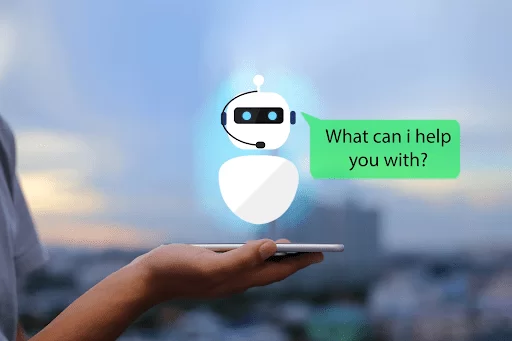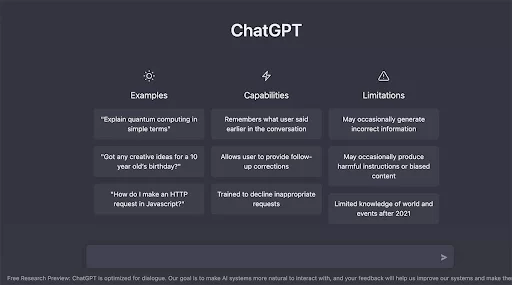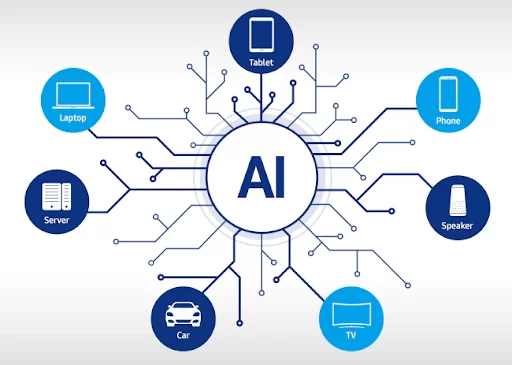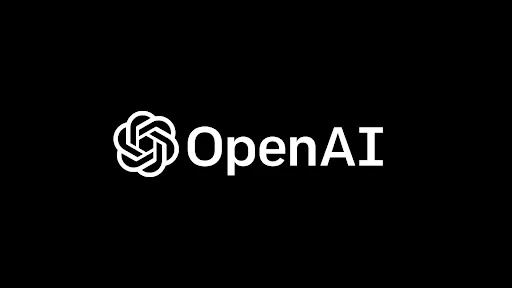Innovation
2023’s Prominent Tech Trends – Chatbots, AI, and Voice Search
Chatbots, AI, And Voice Search: Top Tech Trends of 2023
It’s challenging to develop a list of technology trends for 2023 due to the rapid pace of technological innovation. Breakthroughs that transform our lives seem to occur every day.
For instance, Ameca, a humanoid robot, made a significant breakthrough in 2022 with its smooth body movements and ability to display various facial expressions. These features make it an ideal choice for seamless customer interactions.
In this blog, we’ll explore the top tech trends of 2023. We’ll look at how these technologies are evolving and how they will impact our lives in the future.
So, let’s get ready to explore the exciting world of cutting-edge tech!
1. Chatbots

Chatbots are crucial in ensuring a company’s success and growth in today’s fast-paced and constantly evolving market. They provide numerous opportunities for businesses to become more efficient and adaptable. The future of chatbots is centred on their capacity to automate tasks previously only achievable by human beings.
According to a report by Grand View Research, the global chatbot market size is expected to reach $1.4 billion by 2024, growing at a compound annual growth rate (CAGR) of 25.7% from 2023 to 2030. This growth is driven by the increasing demand for AI-powered chatbots that can understand natural language and provide personalized experiences.
Voice search is becoming so popular that Google has announced plans to enhance the capability of voice input-based results.
Six areas where chatbots are gaining rapid traction include:
Healthcare – Chatbots can automate routine tasks such as appointment scheduling, prescription refills, and triaging patients. Ada health is one such example of a healthcare chatbot. This can free up doctors and nurses to focus on more complex tasks, improving patient outcomes.
E-commerce – Chatbots can help customers find products, answer questions, and process orders, improving the shopping experience. According to Tidio, 62% of businesses plan to use chatbots, and 19% have already implemented them. H&M, the fashion retailer, has integrated a chatbot into its website and mobile app to help customers find products, answer questions, and provide style advice.
Customer service: Chatbots are increasingly used to provide 24/7 customer service and support. They can help customers with simple queries, provide product recommendations, and escalate complex issues to human agents when necessary. Capital One, the US-based bank, has developed a chatbot called “Eno” to help customers with account inquiries, transaction history, and payment schedules.
Finance: Chatbots are being used by banks and financial institutions to provide customer service, assist with transactions, and provide financial advice. For example, Mastercard has developed “KAI“. The chatbot helps customers with transactions, account balance inquiries, and help with financial literacy.
Education: Chatbots are used in education to provide personalized learning experiences, assist with homework, and answer student questions. Duolingo, the language learning app, created chatbot characters to help users practice their language skills through conversation.
Travel: Chatbots are being used by travel companies to provide information on flights, hotels, and travel destinations. They can also help customers book and manage their travel arrangements. Expedia, the online travel agency, has a chatbot on Facebook Messenger that can help customers with travel bookings, recommendations, and support.
The chatbot industry in 2023 saw the rise of ChatGPT and many other similar tools. ChatGPT attracted 100 million users in just two months, an extraordinary achievement. Such a rapid uptake is a testament to the power of AI and natural language processing in meeting the needs and expectations of users.

Here’s what ChatGPT is capable of:
- ChatGPT can create content based on user prompts, including writing songs and enhancing writing style.
- It can potentially generate detailed Augmented Reality (AR) scenarios for AI art.
- ChatGPT can process, write, and debug code, including generating SQL queries.
- The tool can manipulate and organize unstructured data, such as adding data to a table and understanding JSON queries.
- ChatGPT can explain various topics, including words, code, and physics, and could potentially revolutionize the education tech industry as an AI tutor.
- Ed-tech companies can use ChatGPT to provide a platform for students to ask questions and clear their doubts.
Chatbots like ChatGPT are expected to become even more ubiquitous in the coming years. More businesses and organizations will use conversational chatbots to automate customer service, sales, and other interactions.
How can businesses implement chatbots effectively to stay ahead of the competition?
To implement chatbots effectively, businesses need to ensure that their chatbots are well-designed, intuitive, and able to understand customer queries accurately. Chatbots should also be integrated with systems such as customer relationship management (CRM) and enterprise resource planning (ERP) software to provide a seamless customer experience.
2. Artificial Intelligence

By 2023, artificial intelligence (AI) will transform from technical and complex to user-friendly and accessible through easy drag-and-drop interfaces. This will give rise to the concept of no-code AI, where individuals without coding knowledge can utilize the power of AI without writing a single line of code.
The widespread adoption of computers by the masses is a testimony that:
- Operating systems are now used without a technical background in programming.
- AI operations and solutions will become more functional, leading to smarter products that leverage AI-based intelligence.
The emergence of no-code AI can potentially revolutionize various sectors of the economy, especially the manufacturing industry, where AI adoption has been significant.
With no-code AI, even individuals who lack technical expertise can improve their workflow, benefiting stakeholders such as quality assurance engineers, control engineers, and product designers who operate at the forefront of manufacturing processes.
By enabling the construction of no-code AI solutions that are tailored to meet real-world manufacturing requirements, no-code solutions can:
- Automate industrial operations.
- Drive unprecedented levels of quality improvement, efficiency, and profitability for businesses.
- Mitigate risks and increase overall efficiency in manufacturing organizations, enabling them to launch products faster and at a lower cost.
On the other hand, OpenAI, which started as a non-profit research laboratory, has rapidly expanded and is now valued at $29 billion, per a recent report by the Wall Street Journal. This has propelled it to become one of the most valuable startups in the United States.

OpenAI offers several benefits in the field of artificial intelligence, including:
- Advancing research: OpenAI is dedicated to advancing research in AI and making significant contributions toward solving some of society’s most complex problems. It funds cutting-edge research and collaborates with leading experts to develop new AI algorithms and models.
- Developing safe AI: OpenAI is committed to developing safe and beneficial AI, ensuring that AI systems are designed to align with human values and ethics, and minimizing the risks of unintended consequences.
- Democratizing AI: OpenAI aims to make AI accessible to a wide range of people, not just those with advanced technical skills. It offers several open-source tools and resources, including GPT-3, a language model capable of generating human-like text.
- Promoting Collaboration: OpenAI promotes collaboration with the Open AI API community forum, where people can share their thoughts and queries about Open AI products. This helps promote collaboration, accelerate progress, and develop AI openly and transparently.
How can businesses implement AI effectively to stay ahead of the competition?
Businesses must invest in tools and technologies, such as ML algorithms, data analytics software, and natural language processing tools, for seamless AI integration. They also need to ensure their employees are trained to use AI and understand how to leverage it to improve their work.
Voice Search

Searching was a straightforward experience five years ago: You typed your query into Google or Bing, and a results list appeared. Today, our relationship with search has changed dramatically. We no longer want just answers; we want experiences.
Voice search transforms how we interact with information, opening up new opportunities for brands to engage with consumers more humanely.
According to demandsage, over one billion voice searches are conducted every month. This suggests that more people rely on voice search as a convenient and hands-free way to search for information.
The popularity of voice assistants like Amazon’s Alexa, Google Assistant, and Apple’s Siri has contributed to the rise of voice search. These virtual assistants have become increasingly sophisticated and accurate, making it easier for users to find what they’re looking for quickly.
Another factor driving the growth of voice search is the increasing number of smart devices in homes and offices. Smart speakers, such as Amazon Echo and Google Home, have become more affordable and accessible, making them a common feature in many households.
Businesses have also recognized the importance of optimizing their websites for voice search. Here are two statistics that back this claim up:
- A study by upcity found that 50% of adults in the US use voice search at least once per day.
- 27% of all mobile searches are voice searches.
This indicates that businesses that don’t prioritize voice search optimization risk losing potential customers who rely on voice search to find products and services.
How can businesses implement voice search effectively to stay ahead of the competition?
Businesses can use voice search effectively by ensuring their website and content are optimized for voice search. This means:
- Using natural language and conversational keywords and phrases
- Ensuring that their website is mobile-friendly
- Using structured data markup makes it easier for search engines to understand their content.
A Promising Future In Tech As The World Moves Forward In 2023
As we move into 2023, it’s clear that chatbots, AI, ChatGPT, and voice search will continue to play a crucial role in shaping the future of technology. With the integration of these technologies into various industries, we expect to see increased efficiency, improved customer experiences and enhanced productivity.
As an AI language model, ChatGPT is a prime example of how AI and chatbots are transforming the way we communicate and interact with technology. With its ability to understand natural language and generate human-like responses, ChatGPT is revolutionizing how we access information and engage with technology.
Overall, the future of technology looks bright, with these emerging technologies leading the way. As businesses and individuals continue adapting and adopting these innovations, we expect exciting developments in the coming years.
Innovify is a valuable contributor to the development and implementation of emerging technologies. Their innovative approach experienced team, and focus on user-centric solutions make them a reliable partner for companies looking to embrace the latest technological advancements. By leveraging their expertise in fields such as artificial intelligence, blockchain, and IoT, Innovify is helping businesses across industries stay ahead of the curve and drive growth through digital transformation.
FAQs
What are DevOps tools and technologies?
DevOps tools and technologies refer to a set of software solutions and platforms designed to automate and streamline the software development process, enabling collaboration, continuous integration, delivery, and deployment.
Which DevOps tools are commonly used in the industry?
Some popular DevOps tools include Jenkins, Docker, Kubernetes, Ansible, Git, Bitbucket, CircleCI, Jira, SonarQube, Splunk, and New Relic, among others.
How can DevOps tools and technologies benefit software development teams?
DevOps tools and technologies offer several benefits, such as improved collaboration, faster release cycles, automated testing and deployment, scalability, enhanced monitoring and troubleshooting capabilities, and overall increased efficiency in the development process.
Are there any specific tools for infrastructure provisioning in DevOps?
Yes, tools like Terraform and Ansible are commonly used for infrastructure provisioning in the DevOps ecosystem. These tools help automate the deployment and management of infrastructure resources, making it easier to define and provision infrastructure as code.
How can I choose the right DevOps tools for my project or organization?
When selecting DevOps tools, consider factors such as your specific project requirements, team size, scalability needs, integration capabilities, ease of use, community support, and compatibility with your existing infrastructure. It’s also beneficial to evaluate and compare different tools before making a decision.



